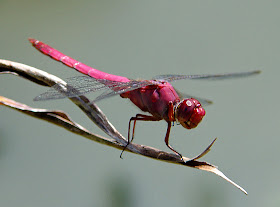 Dragonflies are worldwide in distribution with more than 5,000 described species. There are about 450 species of dragonflies in North America. Dragonfly adults are medium to large insects. In fact, a fossilized dragonfly from 250 million years ago has a wingspan of 28 inches. Fortunately, present-day dragonflies are considerably smaller. Dragonfly adults are often brightly colored and have a long slender abdomen. They also have two pair of long, slender wings with many net-like veins. The wings do not fold and are held outstretched when at rest. Adults are usually found near water but are good fliers and may range several miles. They are active during the day, and can be observed hunting and mating. Males of some species are territorial, defending their domain from other males who enter.
Dragonflies are worldwide in distribution with more than 5,000 described species. There are about 450 species of dragonflies in North America. Dragonfly adults are medium to large insects. In fact, a fossilized dragonfly from 250 million years ago has a wingspan of 28 inches. Fortunately, present-day dragonflies are considerably smaller. Dragonfly adults are often brightly colored and have a long slender abdomen. They also have two pair of long, slender wings with many net-like veins. The wings do not fold and are held outstretched when at rest. Adults are usually found near water but are good fliers and may range several miles. They are active during the day, and can be observed hunting and mating. Males of some species are territorial, defending their domain from other males who enter. The life cycle of the dragonfly, from egg to death of adult, is from six months to as much as six or seven years. Sometimes female dragonflies lay eggs in the small cleft between mud or moss. Most of their life time is spent in the larval (nymph) form, beneath the water surface, using their gills to breathe, catching other invertebrates, such as tadpoles, or even tiny fish. In the adult (flying) stage larger species of dragonfly can live as long as four months. Dragonflies have about 30,000 facets to their eyes, giving them nearly a 360° field of vision.
The life cycle of the dragonfly, from egg to death of adult, is from six months to as much as six or seven years. Sometimes female dragonflies lay eggs in the small cleft between mud or moss. Most of their life time is spent in the larval (nymph) form, beneath the water surface, using their gills to breathe, catching other invertebrates, such as tadpoles, or even tiny fish. In the adult (flying) stage larger species of dragonfly can live as long as four months. Dragonflies have about 30,000 facets to their eyes, giving them nearly a 360° field of vision.Dragonflies and damselflies together make up the order Odonata. Dragonflies make up the suborder Anisoptera, damselflies make up the suborder Zygoptera. The green darner is classified as Anax junius. The American ruby-spot is classified as Hetaerina americana; the black-winged damselfly is Calopteryx maculata.
Dragonfly
Dragonfly
Dragonfly
Dragonfly
Dragonfly






No comments:
Post a Comment